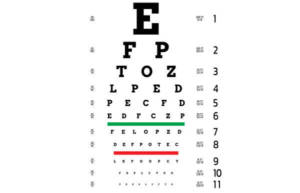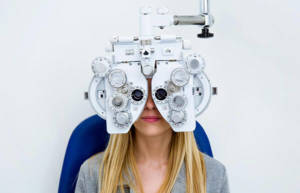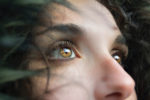Your eyes are one of the most complex organs in your body. Regular eye exams are part of your health prevention.
During a comprehensive eye examyour optometrist examines your eyes for common eye diseases, assesses your eye health and uses your eyes as an indicator of your overall health.
The results of these tests also determine the prescription of your glasses or contact lenses.
The exam can last anywhere from 30 minutes to an hour and includes some or all of the tests below.
Patient history
One of the first steps in a comprehensive eye exam is to learn about your medical history. The optician will ask you about your general health, your vision health, your family history of vision problems and any medications you are currently taking.
He or she may also ask you about eye injuries, medications or procedures you may have had in the past.
This information helps your optometrist create a personalized treatment plan.
Visual acuity test

The visual acuity test is one of the most common eye tests. This test measures your visual acuity. In other words, it measures the sharpness of your vision with a chart projected on the wall.
Using one eye at a time, your optometrist will ask you to identify different letters or numbers on the chart that is displayed at a certain distance from you.
As you read each line aloud, the letters get smaller until you can no longer read the screen.
The results are written in a format such as 20/20, 20/40 etc. which is a comparison of your vision to that of a person with good vision, which is usually 20/20.
For example, a patient with 20/40 vision cannot see at 20 feet what a normal person can see at a distance of 40 feet.
Retinoscopy
Retinoscopy is performed as part of a regular eye exam to determine if your eyes have refractive errors such as emmetropia, nearsightedness, farsightedness or astigmatism and if corrective lenses are needed to achieve clear vision.
It is often used to identify vision problems in children and patients who are unable to answer the optometrist’s questions accurately.
In retinoscopy, your optometrist will use an instrument called a retinoscope to project a beam of light into the eye.
As the light is moved vertically and horizontally over the eye, the optometrist observes the angle of refraction of the light from the retinoscope on your retina and your eye’s ability to focus. If you cannot focus properly, the optometrist uses a set of lenses. It constantly changes the lenses until it indicates the lens power that indicates the patient’s refractive error.
Refraction test

Starting with the basic prescription determined by retinoscopy, the optometrist uses a refraction test to determine your exact prescription for glasses or contact lenses.
During a refraction test, your optometrist will place an instrument called a phoropter in front of your eyes that displays lenses of different intensities. It changes lenses in front of each eye while you read letters and numbers on a board. The optometrist will ask you several times which lens makes your vision clearer.
Based on your answers, your optometrist will determine which lens is best for you.
Visual field test
A visual field test measures your entire field of vision, including central and peripheral (side) vision.
The visual field test evaluates the visual fields of each eye individually and can detect blind spots (scotomas) as well as central and peripheral vision dysfunctions that may be caused by various medical conditions such as glaucoma, stroke, brain tumors, etc.
Glaucoma detection test
This procedure checks to see if the fluid pressure inside your eyes is within the normal range.
Your optometrist puts specific drops in your eyes to numb them. Then he asks you to look straight into a slit lamp and he gently touches the front surface of your eye with an instrument called a tonometer that measures pressure.
There are no warning signs or painful symptoms of glaucoma and you only discover it after you have experienced significant vision loss. Therefore, testing for glaucoma in your regular eye exam allows you to detect glaucoma at an early stage and take preventive measures.
To learn more, contact our team of qualified optometrists at Lindegger Optique, Geneva.
Make an appointment for a complete eye exam and prescription for vision correction today!





